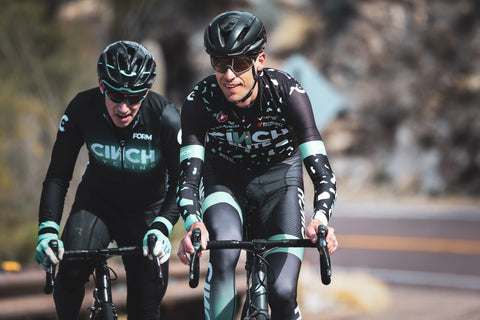Climbing is one of the most important disciplines in the sport of cycling. In this blog I am going to share with you three different places you can improve your climbing: strategy, technique, and mindset.
Climbing strategy:
Here are six powerful strategies that we use with our CINCH clients that have helped them improve their climbing performances.
- Don’t surge at the base of the climb to try and keep up, or to try to fight your dropping speed. Instead, hold back and feel out the climb. Find a pace that you can increase your effort from later on in the climb.
- Set your respiration rate to one that you are able to deeply exhale at the end of each breathe. This is key because your respiration rate and depth of each breathe act as your guide all the way up the climb on how hard you can go. Those short, shallow breathes mean your pace is NOT sustainable and the universe will intervene shortly by slowing your pace WAY down.
- Don’t fight it, flow with it. This means pushing the pace on the transitions from steep to flatter gradient while holding back on the transitions from flat to steep gradients. Don’t fight it, flow with it.
- Change your cadence constantly to manage the different gradients. Use a lower cadence most of the climb to prevent the steeper parts of the climb from taking you over your zones. Then use a higher cadence to build speed on the flatter sections.
- Look ahead. Don’t be a victim of the climb! Instead, look in advance and take control by “driving” the climb as you would in a car by proactively planning your actions around what’s coming.
- See your effort through until the end of the climb. Don’t change how hard you try, or how much of the climb you try based on what others do at the bottom.

Climbing Technique:
Standing is a big part of climbing performance. While you may feel inefficient standing, it will help you climb faster and at the end of the day, with less effort.
There are five climbing standing techniques that will take your riding uphill to new heights, literally!
1. Thumbs up and forward for control and maximum stability for power leverage.
2. Chest low and chin in front of front hub to support body weight on triceps.
3. Elbow in on downstroke to lock core for full power transfer.
4. Heels up as to snap up on the upstroke.
5. Shift bike to the opposite side of the downstroke that you drop your body weight into the downstroke.

Climbing Mindset:
Climbing is one of the most difficult components of cycling. It challenges your physical strength as all as your mental toughness.
One thing you can do to help your mind overcome the physical challenges of climbing is proactively place positive mental cues before the typical reactive negative ones set in.
Here are some sample cue words that we have found to be effective that will help you find that optimal state when climbing on the bike (or even when life) gets challenging off the bike.
1. Boss
Be the freaking boss! Your body works for you, you do not work for your body. Practice one way communication DURING your climb. You can have the debrief where you are a good listener when the climb is said and done.
2. Strength
Climbing gives you an opportunity to feel your strength. Going uphill is freaking hard and requires your mental and physical strength. Instead of focusing on the discomfort, pivot your attention to the strength you are using to overcome the climb.
3. Drive
View the climb as if you are driving up it in your car. Read the terrain and use focus to keep your momentum.
4. Breathe
Breathe so you can hear it. Then, just like listening to your car engine tell you when to shift, pay attention to your respiration rate and control your effort like you do with your foot on the gas pedal.
5. Free
Relax and be free. Being tight will just restrict your moment and blood flow. Start with parts of your body that are already pain free, such as your hands. Relax them on your handlebars and then try and relax each muscle group from the hands all the way through your body.
6. Humility
Climbing is humbling, there is no way around that. If struggling up a mountain doesn’t make you feel vulnerable, you are not doing it right. It’s ok to feel like you are “not a climber.” You are doing it right and the sense of humility you feel from it is what you are signing up for each time you start up a climb.
7. Patience
Start the climb conservatively and let your momentum from before the climb carry you up the first part.

